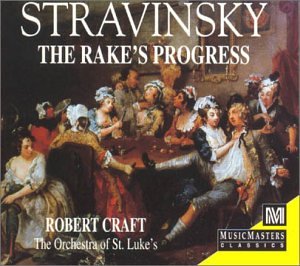Music with Ease > 20th Century Opera > The Rake's Progress (by Igor Stravinsky)
The Rake's Progress
(by Igor Stravinsky)
Opera in three acts and an epilogue.
Premiere: Venice, Italy, 1951.
Libretto: Written by W. H. Auden and Chester Kallman after a series of etchings entitled A Rake's Progress (1735) by William Hogarth, the British artist and satirist.

The Rake's Progress with the Orchestra of St Luke's. Conductor: Robert Craft.
Available from: amazon.com.
Act 1
Tom Rakewell lives in the countryside with his sweetheart, Anne Truelove. But when asked to find a job, Tom seeks an easier route and is lured to the big city of London by the devilish Nick Shadow. Tom agrees to employ Shadow as his manservant for a year and a day and he ends up in Mother Goose's brothel. Tom is tempted by talk of the high life and of pleasure but when the word love happens to be mentioned, he wants to leave but is taken to bed by Mother Goose. The faithful Anne journeys to London to find out where Tom has disappeared to.
Act 2
Tom tires of fast women and the profligate lifestyle. Shadow suggests Tom marry Baba the bearded Turkish lady. Anne arrives but Tom tells her to leave him to his fate. Shadow gets Tom to invest his remaining money in a machine that is claimed to turn stones into bread. This crazy money-making scheme causes Tom to become bankrupt.
Act 3
All of Tom's belongings are auctioned off in order to pay his creditors. In a churchyard one evening Shadow demands immediate payment for his services and when Tom says he cannot pay, Shadow says that Tom must commit suicide at midnight. At the last moment Shadow relents and says Tom and he can play cards, with Tom losing his soul if he loses. Unexpectedly Tom wins and a furious Shadow sends Tom insane instead. The following day Tom is in the mental asylum. He is imaging he is Adonis waiting on Venus to come. All the other inmates ignore him. The faithful Anne comes to pay him one final visit.
Epilogue
The players assemble to sing: "For idle hands and hearts and minds, the Devil finds a work to do".
Study Notes
Igor Stravinsky is most famed for ballets scores, notably for The Firebird (L'Oiseau de feu), Petruska (Petrouska) and The Rite of Spring (Le sacre du printemps). These scores shocked the audiences of the time with their fierce rhythms and fantastic orchestral colouring.
After the Russian Revolution and the end of the Great War, Stravinsky left Russia and lived in Europe and later the United States.
During this period that his music moved into a neo-classical phase and was then that Stravinsky wort his longest opera, The Rake's Progress, which combined neo-classical and contrapuntal elements.
Inspired by the Hogarth prints that he saw at a Chicago exhibition in 1947, Stravinsky wrote a score for The Rake's Progress that was a pastiche of an 18th century opera (drawing on Mozart's operas, including a coloratura soprano aria). The opera score also included recitatives (recalling Stravinsky's earlier in ritual forms in his Rite of Spring) accompanied by a harpsichord.
Like Mozart's Don Giovanni, an opera that chronicles the moral fall of a flawed character, Stravinsky's opera also has a strong underlying moral message (being the tale of a young libertine who falls from grace and realises too late that he has lost a fortune, true love and sanity).
Share this page:
Author: David Paul Wagner
(David Paul Wagner on Google+)
Music With Ease | About Us | Contact Us | Privacy | Sitemap | Copyright | Terms of Use © 2005-25 musicwithease.com. All Rights Reserved. |
